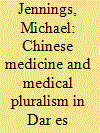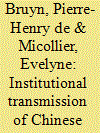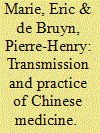| Srl | Item |
| 1 |
ID:
067375


|
|
|
| 2 |
ID:
110585


|
|
|
|
|
| Publication |
2011.
|
| Summary/Abstract |
In November 2010, UNESCO included "Acupuncture and moxibustion as part of Chinese traditional medicine" on its Representative List of the Intangible Cultural Heritage of Humanity. Already in 2006, a national list of oral and intangible masterpieces of heritage was drawnup. Nine of them pertained to medicine and traditional pharmacopoeia. Since then, two other national lists have been compiled, containing medical elements. This article analyses the challenges of Chinese medicine's "patrimonialisation" by retracing the discipline's recent as well as much older history. Contents of different lists are examined in this perspective. Chinese medicine finds itself in a paradoxical situation, compared in practical terms with biomedicine, in perpetual reclassification, and held up for good or for bad reasons. Its inclusion in the cultural heritage list highlights many problematic issues, such as master-disciple transmission, vague teaching methods, questions as to the scientific nature or otherwise of its practices, and the industrialisation of its pharmacopoeia. In conclusion, questions may be raised over the link between protection and denaturation throughout the heritage designation process.
|
|
|
|
|
|
|
|
|
|
|
|
|
|
|
|
| 3 |
ID:
110588


|
|
|
|
|
| Publication |
2011.
|
| Summary/Abstract |
This article is based on the results of comparative research into the appearance and integration of Chinese medicine (often limited to acupuncture in Europe) into French and Italian medical contexts during the twentieth century. The relationship between Chinese and conventional medicine and attempts at complementarity are studied, using as a starting-point a vast number of interviews with medical practitioners, observations of training sessions in the field, the study of the archives of the major French and Italian associations and schools of acupuncture and Chinese medicine, and a qualitative analysis of questionnaires distributed in training institutions. The motivations of French and Italian acupuncturists are also analysed, as are their representations of Chinese medicine. Particular attention is paid to a comparison between the French and Italian situations.
|
|
|
|
|
|
|
|
|
|
|
|
|
|
|
|
| 4 |
ID:
110586


|
|
|
|
|
| Publication |
2011.
|
| Summary/Abstract |
The aim of this article is to propose a typology of the different issues that the transmission of traditional Chinese medicine encounters today in the world, by successively highlighting ideological, epistemological, political, and educational difficulties. After showing how much the polarised aspect of the debates on Chinese medicine is already entrenched among specialists in this discipline, we explore the question of the epistemological status of this Chinese tradition by confronting it with the dominant biomedicine of Western origin. The originality of Chinese structures that were set up to protect and promote this national tradition is then highlighted as a possible source of inspiration at the international level, before describing the different economic factors likely to play a positive or negative role in the development of this medical and cultural heritage at the local level. Finally, the specific didactic questions that the transmission of this heritage and the teaching of this discipline raise are analysed before presenting a conclusion.
|
|
|
|
|
|
|
|
|
|
|
|
|
|
|
|
| 5 |
ID:
086710


|
|
|
|
|
| Publication |
2009.
|
| Summary/Abstract |
In the context of a social and medical response to AIDS at a national level recommended by the Chinese authorities, the policy of eventual extension of treatment to all patients reveals "Chinese characteristics" that are akin to international concerns regarding the use of alternative and complementary medicine. One concerns the use of traditional Chinese medicine (TCM), principally in combined treatment (biomedicine with Chinese medicine) in a public health system in which it plays a relatively large part compared to other health systems in the world. This article focuses on the integration of TCM in therapies and research on HIV/AIDS.
|
|
|
|
|
|
|
|
|
|
|
|
|
|
|
|
| 6 |
ID:
150418


|
|
|
| 7 |
ID:
110584


|
|
|
|
|
| Publication |
2011.
|
| Summary/Abstract |
Chinese medicine is a medical system that was developed in China over a long period of time and has subsequently spread over the rest of the world, especially over recent decades. This study aims first to identify this medicine and to examine the changes that accompanied its institutionalisation in the People's Republic of China starting in the 1950's, then to set out the continuities and breaking points that have characterised the ways in which it is transmitted, from traditional apprenticeship training to the development of national university syllabuses. It then looks into the way in which Chinese medicine has faced up to biomedicine and sets out a comparative analysis of the paradigms of these two systems, before describing the way in which this exotic medicine has been received and adapted in the West. This makes it possible to grasp the difficulties and issues involved in its globalisation and the increasingly pressing need, from the perspective of university teaching and research, for a more complete, objective and pragmatic approach to studying it.
|
|
|
|
|
|
|
|
|
|
|
|
|
|
|
|